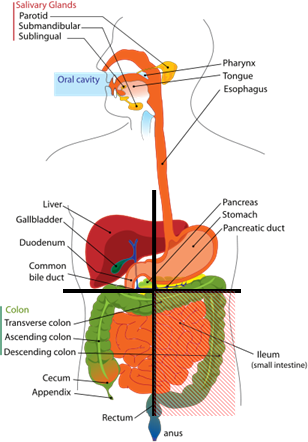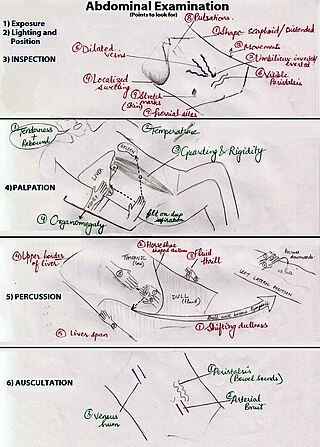
Pankration was an unarmed combat sport introduced into the Greek Olympic Games in 648 BC. The athletes used boxing and wrestling techniques but also others, such as kicking, holds, joint locks, and chokes on the ground, making it similar to modern mixed martial arts. The term comes from the Ancient Greek word παγκράτιον (pankrátion), meaning "all of power".

Appendicitis is inflammation of the appendix. Symptoms commonly include right lower abdominal pain, nausea, vomiting, and decreased appetite. However, approximately 40% of people do not have these typical symptoms. Severe complications of a ruptured appendix include widespread, painful inflammation of the inner lining of the abdominal wall and sepsis.

Crabs are decapod crustaceans of the infraorder Brachyura, which typically have a very short projecting tail-like abdomen, usually hidden entirely under the thorax. They live in all the world's oceans, in freshwater, and on land. They are generally covered with a thick exoskeleton. They generally have five pairs of legs, and they have pincer claws on the ends of the frontmost pair. They first appeared during the Jurassic period, around 200 million years ago.

Peritonitis is inflammation of the localized or generalized peritoneum, the lining of the inner wall of the abdomen and cover of the abdominal organs. Symptoms may include severe pain, swelling of the abdomen, fever, or weight loss. One part or the entire abdomen may be tender. Complications may include shock and acute respiratory distress syndrome.

A tarantula hawk is a spider wasp (Pompilidae) that preys on tarantulas. Tarantula hawks belong to any of the many species in the genera Pepsis and Hemipepsis. They are one of the largest parasitoid wasps, using their sting to paralyze their prey before dragging it into a brood nest as living food; a single egg is laid on the prey, hatching to a larva which eats the still-living host. They are found on all continents other than Europe and Antarctica.

Cholecystectomy is the surgical removal of the gallbladder. Cholecystectomy is a common treatment of symptomatic gallstones and other gallbladder conditions. In 2011, cholecystectomy was the eighth most common operating room procedure performed in hospitals in the United States. Cholecystectomy can be performed either laparoscopically, or via an open surgical technique.

Abdominal pain, also known as a stomach ache, is a symptom associated with both non-serious and serious medical issues. Since the abdomen contains most of the body's vital organs, it can be an indicator of a wide variety of diseases. Given that, approaching the examination of a person and planning of a differential diagnosis is extremely important.

Rovsing's sign, named after the Danish surgeon Niels Thorkild Rovsing (1862–1927), is a sign of appendicitis. If palpation of the left lower quadrant of a person's abdomen increases the pain felt in the right lower quadrant, the patient is said to have a positive Rovsing's sign and may have appendicitis. The phenomenon was first described by Swedish surgeon Emil Samuel Perman (1856–1945) writing in the journal Hygiea in 1904.

Gastrointestinal perforation, also known as gastrointestinal rupture, is a hole in the wall of the gastrointestinal tract. The gastrointestinal tract is composed of hollow digestive organs leading from the mouth to the anus. Symptoms of gastrointestinal perforation commonly include severe abdominal pain, nausea, and vomiting. Complications include a painful inflammation of the inner lining of the abdominal wall and sepsis.

An abdominal examination is a portion of the physical examination which a physician or nurse uses to clinically observe the abdomen of a patient for signs of disease. The abdominal examination is conventionally split into four different stages: first, inspection of the patient and the visible characteristics of their abdomen. Auscultation (listening) of the abdomen with a stethoscope. Palpation of the patient's abdomen. Finally, percussion (tapping) of the patient's abdomen and abdominal organs. Depending on the need to test for specific diseases such as ascites, special tests may be performed as a part of the physical examination. An abdominal examination may be performed because the physician suspects a disease of the organs inside the abdominal cavity (including the liver, spleen, large or small intestines), or simply as a part of a complete physical examination for other conditions. In a complete physical examination, the abdominal exam classically follows the respiratory examination and cardiovascular examination.

Faheem Rashad Najm, known professionally as T-Pain, is an American singer, rapper, songwriter, and record producer. He is known for popularizing creative use of Auto-Tune pitch correction, often used with extreme parameter settings to create electronic-styled vocal performances. Blending its use with R&B and hip-hop sensibilities, T-Pain became a prominent figure in both genres throughout the 2000s. Other music industry artists, such as Lil Wayne, Kanye West, Future, and Travis Scott, have since utilized Auto-Tune to a similar effect.

Jeffrey Thomas "Jeff" Pain is an American-born Canadian former skeleton racer who competed from 1995 to 2010. He is regarded as one of the most successful male competitors in the history of the Canadian skeleton program.

The abdomen is the front part of the torso between the thorax (chest) and pelvis in humans and in other vertebrates. The area occupied by the abdomen is called the abdominal cavity. In arthropods, it is the posterior tagma of the body; it follows the thorax or cephalothorax.
Tatsuhiko Kubo is a former Japanese football player. He played for Japan national team.
In medicine, tenderness is pain or discomfort when an affected area is touched. It should not be confused with the pain that a patient perceives without touching. Pain is patient's perception, while tenderness is a sign that a clinician elicits.
Uthman ibn al-Huwayrith was an Arab of the Quraysh who was one of the four major hanifs during the time of the Islamic prophet Muhammad, and converted to Christianity. After revolting against idol worship in Mecca in favor of monotheism during the late 6th century, he sought assistance from the Byzantine Empire in 590 in a ploy to install himself as king of Mecca. While in Byzantium, he converted to Christianity. He is also known for having compiled poetic works.

Vikas Krishan Yadav is an Indian boxer from Bhiwani district in Haryana, the hub of some of India's best boxers. He won a gold medal in the 2010 Asian Games in the Lightweight category and a gold medal in 75 kg weight category at the 2018 Commonwealth Games. He is one of the best boxers of India. He also boxed professionally.

The Saudi Arabia national basketball team is the national basketball team representing the Kingdom of Saudi Arabia. It is administered by the Saudi Arabian Basketball Federation.

Metal Gear Solid V: The Phantom Pain is a 2015 action-adventure stealth video game developed and published by Konami. Directed, written, and designed by Hideo Kojima, it is the ninth installment in the Metal Gear franchise, following Metal Gear Solid V: Ground Zeroes, a stand-alone prologue released the previous year. Set in 1984, nine years after the events of Ground Zeroes, the story follows mercenary leader Punished "Venom" Snake as he ventures into Soviet-occupied Afghanistan and the Angola–Zaire border region to exact revenge on those who destroyed his forces and came close to killing him during the climax of Ground Zeroes.















